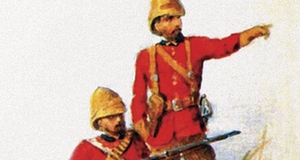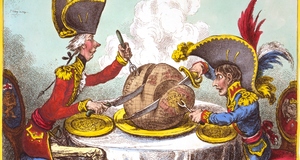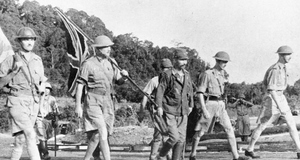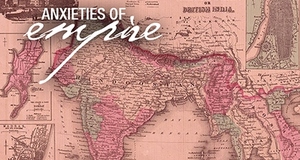|
Featured Article: Rudyard Kipling's Literary and Historical Legacy
Critical opinion of Rudyard Kipling, his imperialism, and his oeuvre has radically changed in the last century. Depending on the literary history and the time period, Kipling has been seen as either an exclusively South African poet (Warren 415), or “as little of an imperialist as Conrad” (Fowler 337). Always, however, he is a poet, novelist, and short story writer of the British Empire, whether or not critics believe Kipling supports that empire in his oeuvre. One measure of critics’ praise or censure is their critical opinion of Kim (1901). Although few think the novel has great literary merit, they consider it either as a measure of Kipling’s “schoolboy imperialism” (Daiches 1091), or as one with “merits of [its] own” (Legouis and Cazamian 1340). Another dilemma for literary historians is which literary-historical period should claim Kipling: the Victorians or the modernists. Those who consider Kipling a modern poet and novelist think less of his imperialism than those who place him with the Victorians. Yet Kipling is both Victorian and modern.
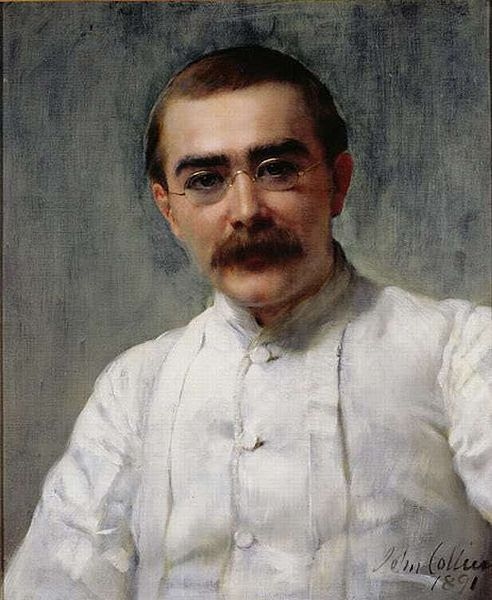
Portrait of Rudyard Kipling by John Collier, c. 1891
The Cambridge History of English Literature (1917), in its three volumes (XII‑XIV) devoted to the nineteenth century, excludes Kipling. He is mentioned in volume XIV only once, in the context of South African poetry, and only as an introduction to Herbert Warren’s discussion of South African poet Thomas Pringle (1789‑1837), who later became a friend of Sir Walter Scott and editor of Blackwood’s Magazine, and whom Kipling highly praises (415). Today, Thomas Pringle’s poetry would not warrant a critical discussion in British literature. Although Warren acknowledges Kipling’s poetic powers, he thinks Kipling is “the foremost English poet of South Africa,” not of England (415, italics mine). Warren then describes Kipling’s “influence on many, if not most, of the living poets of this part of the empire” (423, italics mine), not on poets of British India. By placing Kipling among South African poets, Warren does not recognize the value of his Indian or English poetry; there is no mention of the famous “Recessional” (1897).
There are many possible reasons for Kipling’s exclusion from The Cambridge History. Warren states, “Of Rudyard Kipling and his influence . . . it is not permissible to take this occasion of speaking” (423). Kipling was still alive when this history was written, although he would have been past his literary prime in 1917. Possibly, the authors and editors of The Cambridge History did not sense enough historical distance to judge the value of Kipling’s work. They might have thought him a modern poet, which could explain his exclusion. Much of Kipling’s work was popular in its heyday (c. 1890‑1910), including “Recessional” (1897), The Jungle Book (1894‑95), and Kim. However, Kipling’s imperialism was not popular in 1917 (Young 514-15). As either poet or novelist, he did not warrant a discussion in The Cambridge History of English Literature.
The Cambridge History spends three volumes on the nineteenth century, the first two on Romantic (c. 1795-1930) and Victorian (c. 1830-1900) literature. The third is a hodgepodge of what did not seem to fit into the canon of nineteenth-century English literature. This volume is organized by genre and place, with chapters on philosophers, historians and biographers, critical prose (e.g. Ruskin), journalism, travel literature, Anglo‑Irish literature, Anglo‑Indian literature, English‑Canadian literature, the literature of Australia and New Zealand, and changes in the English language. Most of the volume discusses very minor authors. The chapter on Anglo-Indian literature includes discussions on Macauley and Hastings, but no Kipling appears where he should. An excellent bibliography concludes the volume, but its organization is highly erratic, since it discusses non-standard genres, and many extremely minor authors, in English literature.
Emile Legouis and Louis Cazamian’s A History of English Literature (1935), published less than twenty years later, differs in its critical opinion of Kipling. The authors discuss him in the context of post-1900 “doctrines of action:” imperialism, traditionalism, and socialism (1331). These movements, reacting against aestheticism and decadence, focused on “self-assertion of the will” (1331). In seven pages, Kipling is compared with William Henley (imperialism), G. K. Chesterton (traditionalism), Shaw and Wells (socialism). The authors consider Kipling a better writer than Henley, whose “personality is more interesting than his work” (1332-33). Discussing mostly his style, Legouis and Cazamian consider Kipling the voice of empire exalting the British soldier who sacrifices his desires for the “brotherhood” (1336-37). Little of their criticism is negative, since the authors are French. They compare Kipling to Whitman, since they think his “poetry has a democratic ring” (1341-42) and “reminds the reader of the old English ballads” (1341). The authors consider him the “master” of the short story, in the manner of Maupassant (1338).
Legouis and Cazamian’s critical opinion of individual works is uneven. They never name specific poems or stories that would qualify their praise, since they consider Kipling’s Barrack Room Ballads (1892) “very unequal” (1341). Legouis and Cazamian think epic works like The Rhyme of the Three Sealers “[are] surpassed by nothing in modern English literature” (1342). No critic today discusses this work, and few Kipling enthusiasts have heard of it. Although the authors acknowledge two of Kipling’s English story collections, Puck of Pook’s Hill (1906) and Rewards and Fairies (1910), these “charming” works “no longer bear the stamp of genius” (1342). Legouis and Cazamian think “it would be a hasty and unjustified assumption to conclude that” works like The Light That Failed (1891) and Kim “are of inferior worth,” since they “have merits of their own” (1340). However, the authors think “Kipling does not burrow deep into” human character because that was not his goal (1340). This is not true with Kim, whose character develops over five years. According to the authors, The Jungle Books, even if not Kipling’s best, “are his most representative work” (1341), a judgment The Routledge History of English Literature (1997) also holds (322).
A History of English Literature contains two literary histories in one, spanning A.D. 650 to the early twentieth century. The work is certainly comprehensive, with miniature biographies, a list of primary works, and secondary source recommendations for each author in footnotes. The two-in-one volume discusses both major and minor authors and is organized by historical periods. I like that it relates major authors to other authors and their representative periods, with a discussion of style. However, most of the authors’ discussion of Kipling is not in-depth; I wonder how much of their critical discussion of other major authors resembles this pattern.
Before World War II, critics concentrated on Kipling’s longer works, alongside a discussion of his style and his imperialism. After this period, critics added specific poems to their discussion; except for J. I. M.’s pioneering study, few critics discussed specific stories by name. Although most critics’ opinion of Kim changed little, they placed more emphasis on how Kipling’s imperialism influenced his work, depending on popular opinion. Unlike the early critics, who consider Kipling’s imperialism a positive force in his work, the later critics consider it a negative one.
J. I. M. Stewart’s Eight Modern Writers (1963) devotes an entire chapter to Kipling, alongside reviews of Conrad, Hardy, James, Joyce, Lawrence, Shaw, and Yeats. His method of evaluation is offering “a record of the eight who seem to [him] of unchallengeable importance in the period” (vii). He believes these writers, Kipling included, “will remain important landmarks when literary historians come to a fuller survey of the terrain” (vii). Stewart’s evaluation of Kipling’s oeuvre is more comprehensive than that of other historians and critics during this period. However, works like The Light That Failed are no longer considered of literary value; even Stewart thinks it a miserable failure (245-49), a departure from Legouis and Cazamian’s analysis (1340). Some of Kipling’s works Stewart mentions only “because they are so significantly bad” (238). Although Stewart’s discussion of Kipling’s oeuvre resembles critical opinion during this period, regarding Kim many later critics see more than a children’s book. According to Stewart, “we lose contact with Kim when we regard this story of an orphan white boy gone native . . . as other than essentially [a book for young people]” (259). Stewart doubts that “we [would] ever come back to the book when our years exceed its hero’s,” which is roughly sixteen (261). However, Kim has received extensive critical analysis in the last decade or so, by critics much older than sixteen.
Stewart repeatedly compares Kipling’s style and subject matter to Conrad, and sometimes he supersedes the latter. For example, Stewart believes “Carnehan and Dravot,” in “The Man Who Would Be King,” “have more of nature than do some answering characters in the maturest Conrad. Nor can Conrad . . . ever give body and sharp actuality to exotic scenes with the speed and spareness Kipling here achieves” (234). This is a bold analysis, Stewart being the first critic to discuss this now-famous short story of adventure and empire gone wrong in Kafiristan. However, his overview of Kipling is just that: an overview. We do not see the peaks and valleys in Kipling’s oeuvre because there is so much of it. Stewart’s analysis is chronological, where a discussion by genre or place would have been more helpful. Because of the sheer number of works Stewart mentions or discusses, we lose the sense of what is of literary value in the Kipling canon and what can be passed over. What is the merit of discussing stories that are general failures?Continued on Next Page »
- Baldick, Chris. The Modern Movement, 1910-1940. The Oxford English Literary History. Ed. Jonathan Bate. Vol. 10. Oxford, UK: Oxford UP, 2004.
- Beckson, Karl. “The 1890s.” The Columbia History of British Poetry. Eds. Carl Woodring and James Shapiro. New York: Columbia UP, 1994. 505-31.
- Bhatia, Nandi. “Kipling’s Burden: Representing Colonial Authority and Constructing the ‘Other’ through Kimball O’Hara and Babu Hurree Chunder in Kim.” South Asia Graduate Research Journal 1 (1994): 1-8.
- Birkenhead, Robin, Lord. Rudyard Kipling. New York: RandomHouse, 1978.
- Carter, Ronald and John McRae. The Routledge History of Literature in English: Britain and Ireland. London: Routledge, 1997.
- Chaudhuri, Nirad C. “The Finest Story about India -- in English.” Encounter Apr. 1957. Rpt in The Age of Kipling. Ed. John Gross. New York: Simon & Schuster, 1972. 27-35.
- Chew, Samuel C. and Richard D. Altick. The Nineteenth Century and After (1789-1939). A Literary History of England. Ed. Albert C. Baugh. 2nd ed. Vol. 4. New York: Appleton-Century-Crofts, 1967.
- Daiches, David. A Critical History of English Literature. 2nd ed. Vol. 4. London: Secker and Warburg, 1969.
- Fowler, Alistair. A History of English Literature. Cambridge, MA: Harvard UP, 1987.
- Gilmour, David. The Long Recessional: The Imperial Life of Rudyard Kipling. New York: Farrar, Straus, & Giroux, 2002.
- Hubel, Teresa. Whose India?: The Independence Struggle in British and Indian Fiction and History. Durham, NC: DukeUP, 1996.
- Karlin, Danny. “Plain Tales?” Kipling Considered. Ed. Phillip Mallett. New York: St. Martin’s, 1989. 1-18.
- Kemp, Sandra. Kipling’s Hidden Narratives. Oxford, UK: BasilBlackwell, 1988.
- King, Blair B. “Kim in Historical Context.” Kim. Ed. ZohrehT. Sullivan. Norton Critical Editions. New York: Norton, 2002. 297-309.
- Legouis, Emile, and Louis Cazamian. A History of English Literature. Trans. Helen Douglas Irvine, W. D. MacInnes, and Louis Cazamian. 2nd ed. New York: Macmillan, 1935.
- Mallett, Phillip, ed. Kipling Considered. New York: St.Martin’s, 1989.
- McBratney, John. “Images of Indian Women in Rudyard Kipling: A Case of Doubling Discourse.” Center for Cultural Studies 7 Dec. 1998. 20 Oct. 2004.
- Moore-Gilbert, Bart. “Reading Kipling, Reading Bhabha.” Writing India, 1757-1990: The Literature of British India. Ed. Bart Moore-Gilbert. Manchester, UK: Manchester UP, 1996. 111-38.
- Paffard, Mark. Kipling’s Indian Fiction. New York: St.Martin’s, 1989.
- Park, Clara Claiborne. “The River and The Road: Fashions in Forgiveness.” The American Scholar 66 (1997): 43-62.
- Prescott, Lynda. “The White Man’s Burden: Kim.” Literature and Nation: Britain and India, 1800-1990. Eds. Richard Allen and Harish Trivedi. London: Routledge, 2000. 67‑77.
- Reiss, Timothy J. “Mapping Identities: Literature, Nationalism, and Colonialism.” American Literary History 4 (1992): 649-77.
- Roy, Parama. Indian Traffic: Identities in Question in Colonial and Postcolonial India. Berkeley: U of California P, 1998.
- Said, Edward. Culture and Imperialism. New York: Knopf, 1993.
- Stewart, J. I. M. Eight Modern Writers. The Oxford History of English Literature. Eds. F. P. Wilson and Bonamy Dobree. Vol. 12. Oxford, UK: Oxford UP, 1963.
- Suleri, Sara. The Rhetoric of English India. Chicago: U of Chicago P, 1992.
- Warren, T. Herbert. “South African Poetry.” The Nineteenth Century III. The Cambridge History of English Literature. Eds. A. W. Ward and A. R. Waller. Vol. 14. New York: Macmillan, 1917. 414‑24.
- Williams, Patrick. “Kim and Orientalism.” Kipling Considered. Ed. Phillip Mallett. New York: St. Martins, 1989. 33-55. a
- Wilson, Angus. The Strange Ride of Rudyard Kipling: His Life and Works. New York: Viking, 1978.
- Young, G. M. “Joseph (Rudyard) Kipling.” The Dictionary of National Biography, 1931‑1940. Ed. L. G. Wickham Legg. Oxford, UK: Oxford UP, 1949. 512‑16.
Endnotes
1.) See Lord Birkenhead, Rudyard Kipling (1978), 292, 328-29; and Young, “Joseph (Rudyard) Kipling,” The Dictionary of National Biography (1949), 513.
2.) The Oxford History of English Literature, eds. F. P. Wilson and Bonamy Dobree, vol. 12.
3.) See Clara Claiborne Park, “The River and the Road,” 44-45, 62; Lynda Prescott, “The White Man’s Burden: Kim,” 67; and Parama Roy, Indian Traffic, 79. Nirad Chaudhuri (1957) calls Kim “the finest novel [of India] in English” (28).
4.) See Nandi Bhatia (1994), Teresa Hubel (1996), Blair King (2002), Clara Park (1997), Lynda Prescott (2000), Timothy Reiss (1992), Parama Roy (1998), Edward Said (1993), Sara Suleri (1992), and Patrick Williams (1989).
5.) A Literary History of England, ed. Albert C. Baugh, 2nd ed., vol. 4.
6.) See, for example, Phillip Mallett, ed., Kipling Considered (1989); and Mark Paffard, Kipling’s Indian Fiction (1989).
7.) See footnotes 3 and 4.
8.) The Norton Anthology of English Literature, 6th ed., vol. 2, 1674‑78.
9.) See, for example, Danny Karlin, “Plain Tales?” (1989); Sandra Kemp, Kipling’s Hidden Narratives, 1988; Bart Moore-Gilbert, “Reading Kipling, Reading Bhabha,” 1996; and Mark Paffard, Kipling’s Indian Fiction, 1989.
10.) See, for example, John McBratney (1998) and Edward Said (1993).
11.) Legouis and Cazamian, A History of English Literature (1935), describe both Captains Courageous and Stalky and Co., in a footnote on Kipling’s life and work, as “tales for the young” (1334n1).
12.) See, for example, Angus Wilson, The Strange Ride of Rudyard Kipling (1978), 205.
13.) See, for example, Ricketts, “Kipling and the War,” 1986; and Page, “What Happens in ‘Mary Postgate’?” (1986).
14.) See, for example, Karlin, “Plain Tales?” (1989); Kemp, Kipling’s Hidden Narratives, 1988; Mallett, ed., Kipling Considered, 1989; McBratney, Imperial Subjects, Imperial Space, 2002; and Paffard, Kipling’s Indian Fiction, 1989.
15.) David Gilmour, The Long Recessional (2002), said that in a recent BBC poll, “If” was “Britain’s favourite poem” (xi).
16.) See Lord Birkenhead, Rudyard Kipling (1978), 248-51. See also G. M. Young, “Joseph (Rudyard) Kipling,” The Dictionary of National Biography (1949), 514.
17.) See his chapter on “Modernist Fiction” (311-42).
18.) Chris Baldick, The Modern Movement, 1910-1940 (2004), vol. 10 of The Oxford English Literary History.
Suggested Reading from Inquiries Journal
“The Man Who Would Be King” (1888)[1] is one of Rudyard Kipling’s most well known and highly acclaimed short stories. Michael Caine, Sean Connery, and Christopher Plummer starred in John Huston’s classic film adaptation (1975), which provided a testament to the story’s enduring popularity (Beckerman... MORE»
The ‘civilising mission' is a broad ideology that combines four main ideals; Enlightenment ideals, Christian / Evangelical ideas of pre-destination, racist ideas about white superiority and Liberalism. All these ideals... MORE»
Since the end of the Second World War, scholars of British military history have busied themselves with attempts to explain the British defeat at Singapore to Japan in February 1942. Research reveals that there existed what... MORE»
In May 2012, Shakil Afridi received a sentence of thirty-three years “rigorous imprisonment” and a large fine for aiding foreign intelligence gatherers in their quest for Osama bin Laden. The Pakistani state did not charge Afridi – a doctor from the Khyber area of the Federally Administered Tribal Areas (FATA) &... MORE»
Latest in Literature
2023, Vol. 15 No. 02
This literary analysis compares the spiritual landscape of Aldous Huxley’s Brave New World against his nonfiction work, The Perennial Philosophy. In Brave New World, Huxley’s World State appears spiritually promising. It embeds self-... Read Article »
2022, Vol. 14 No. 09
Woolfian Scholars regularly denote the moments where Woolf’s characters feel inexplicably connected and inseparable from one another as representing the spiritual and mystic beliefs of their author. I want to reframe this notion, considering... Read Article »
2022, Vol. 14 No. 09
The Goldfinch (2013) by Donna Tartt is a novel that explores the conditions of grief and escalating lengths characters will go to survive the traumas and mysteries of life. This story of guilt and loss—intermixed with love and longing&mdash... Read Article »
2022, Vol. 14 No. 04
British Poet Laureate Carol Ann Duffy’s The World’s Wife presents a fresh outlook on myths and fairy tales, by retelling them through sociosexually liberated women. The poems feature many themes such as murder, sexuality and childhood... Read Article »
2022, Vol. 14 No. 04
The 17th and 18th centuries saw a wide proliferation of aesthetic discourse through which the picturesque emerged to capture the type of beauty derived from the exchange of in vivo vigor for the spirit of artistic medium. While the metaphysical... Read Article »
2022, Vol. 14 No. 03
This paper explores the complexity of Whitman’s nationalism and, with reference to Leaves of Grass (1856), examines the apparent paradox between Whitman’s poetry of love and recognition and his imperialistic impulses. This paper draws... Read Article »
2022, Vol. 14 No. 02
This article explores the expression of the Gothic romance genre in the 21st century, by examining Mike Flannagan’s The Haunting of Bly Manor. Very little literature focuses on contemporary expressions of this genre. The Gothic reflects the... Read Article »
|










